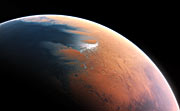
Artist's impression of Mars four billion years ago. An ESO image
WASHINGTON (PTI): A primitive ocean on Mars held more water than Earth's Arctic Ocean but the Red Planet lost 87 per cent of that water to space, a new study has found.
The ocean covered a greater portion of the planet's surface than the Atlantic Ocean does on Earth, researchers said.
An international team of scientists used ESO's Very Large Telescope, along with instruments at the W M Keck Observatory and the NASA Infrared Telescope Facility, to monitor the atmosphere of the planet and map out the properties of water in different parts of Mars' atmosphere.
About four billion years ago, the young planet would have had enough water to cover its entire surface in a liquid layer about 140 metres deep, but it is more likely that the liquid would have pooled to form an ocean occupying almost half of Mars's northern hemisphere, and in some regions reaching depths greater than 1.6 kilometres, researchers said.
"Our study provides a solid estimate of how much water Mars once had, by determining how much water was lost to space," said Geronimo Villanueva, from NASA's Goddard Space Flight Centre in Greenbelt, US, and lead author of the paper published in the journal Science.
"With this work, we can better understand the history of water on Mars," said Villanueva.
The new estimate is based on detailed observations of two slightly different forms of water in Mars's atmosphere. One is the familiar form of water, made with two hydrogen atoms and one oxygen, H2O.
The other is HDO, or semi-heavy water, a naturally occurring variation in which one hydrogen atom is replaced by a heavier form, called deuterium.
As the deuterated form is heavier than normal water, it is less easily lost into space through evaporation. So, the greater the water loss from the planet, the greater the ratio of HDO to H2O in the water that remains.
By comparing the ratio of HDO to H2O, scientists can measure by how much the fraction of HDO has increased and thus determine how much water has escaped into space. This in turn allows the amount of water on Mars at earlier times to be estimated.
The new results show that atmospheric water in the near-polar region was enriched in HDO by a factor of seven relative to Earth's ocean water, implying that water in Mars's permanent ice caps is enriched eight-fold.
Mars must have lost a volume of water 6.5 times larger than the present polar caps to provide such a high level of enrichment. The volume of Mars's early ocean must have been at least 20 million cubic kilometres, researchers said.
Based on the surface of Mars today, a likely location for this water would be the Northern Plains, which have long been considered a good candidate because of their low-lying ground.
"With Mars losing that much water, the planet was very likely wet for a longer period of time than previously thought, suggesting the planet might have been habitable for longer," said Michael Mumma, a senior scientist at Goddard and the second author on the paper.
 Previous Article
Previous Article Next Article
Next Article













The Indian Air Force, in its flight trials evaluation report submitted before the Defence Ministry l..
view articleAn insight into the Medium Multi-Role Combat Aircraft competition...
view articleSky enthusiasts can now spot the International Space Station (ISS) commanded by Indian-American astr..
view article